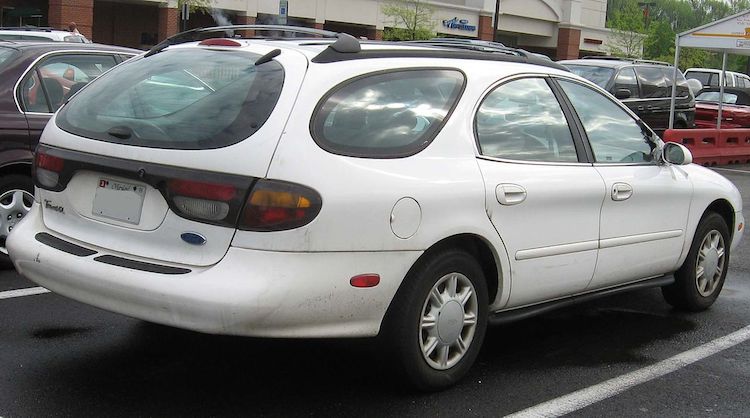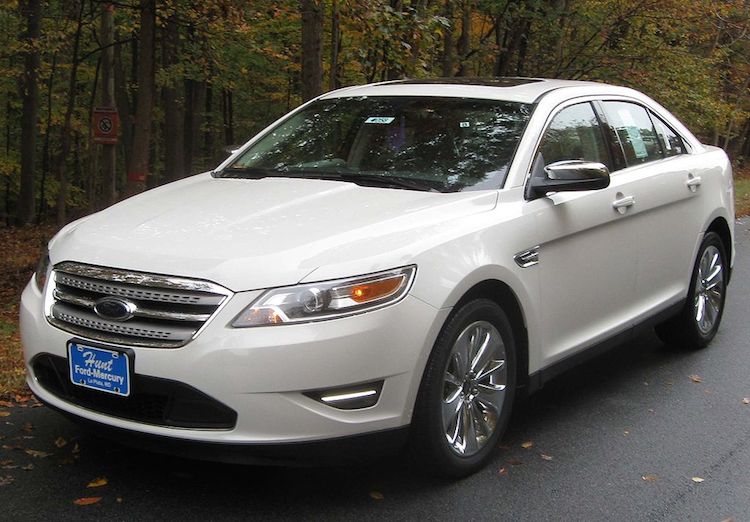The Ford Taurus is a full-size sedan, once one of the most popular models in the blue oval’s arsenal. Changing consumer tastes and Ford’s reluctance to invest in an all-new model took its toll on sales. On March 1, 2019, the last Taurus rolled off of a Chicago assembly line.
Ford claims more than 8 million sales of the Taurus, spanning 34 years of near-continuous build. The very first model debuted at an auto show in 1985 and went into production later that year. Initially, the Taurus was a midsize sedan and wagon. Later, the wagon was dropped and the Taurus name was applied to a full-size sedan.
That sedan competed against the likes of the Chevrolet Impala and Toyota Avalon. Soon, only the Avalon will soldier on as Chevrolet also exits the segment.
8 Highlights of the Ford Taurus
1. Out With the Old
Ford needed a competitive midsize model and set out to build a new vehicle from scratch. The previous LTD was a warmed over Ford Fairmont, one of many models sharing a common Fox-body platform.
Indeed, the Fox architecture supported a variety of models, including the Lincoln Continental and the Ford Mustang.
2. In With the New (Sedan, Wagon, and SHO)

Up until the time of the Taurus’ debut, Ford relied on a succession of rear-wheel-drive models to power its cars. That had Ford trailing its domestic competition, which offered front-wheel-drive models for the taking. FWD was deemed superior from a roominess standpoint as it allowed manufacturers to build smaller vehicles with larger interiors.
The Taurus went up against such models as the Chevrolet Celebrity and the Dodge 600. Initially, Ford introduced the Taurus in sedan and wagon configurations, then followed with a SHO (special high output) performance version beginning in 1989.
The Taurus’ twin was the Mercury Sable; a larger Lincoln Continental shared a modified version of the platform.
3. Success, at Last
Ford recorded a modest 200,000 units sold in the Taurus’ first year, but 2 million models over the first generation’s six-model-year run. Sales continued to climb after that, reaching 410,000 units in 1992. That year also saw the second-generation model’s release, which immediately made the Taurus the best-selling car in America.
Ford would hold onto the title throughout this model’s second-generation run and with the third-generation model when it rolled out in 1996. However, beginning in 1997, the Toyota Camry wrested sales leadership from Ford, keeping the “best-selling car” title most years since.
4. The Ever-popular 3.0L V6
Upon its debut, the Ford Taurus offered two engine choices: a 2.5-liter inline-four and a 3.0-liter V6. The base engine was weak, producing just 90 horsepower to the 140 horsepower offered by the V6. The base engine is paired with a 5-speed manual or a 3-speed automatic transmission, while the V6 works with a four-speed automatic.
The four-cylinder disappeared in early 1991. Beginning in 1988, a 3.8-liter V6 rolled out, matching the horsepower of the standard V6, but with improved torque. The SHO model had its own 3.0-liter V6 engine paired with a 5-speed manual transmission. This engine makes 220 horsepower.
5. On to the Bubble
The Taurus’ sales held strong when the third-generation model rolled out, thanks in large part to rental and fleet sales, which kept this sedan a best-seller. However, customers could not look past the rounded exterior of the new model, with sales soon falling accordingly.
Still, the Taurus name had much value and fleet demand remained strong. The fourth-generation model rectified the design issues of the previous model, continuing with sedan and wagon body styles. However, the SHO was gone and the wagon would follow by the end of 2004.
6. Good-bye, Taurus

Hello, Five Hundred and Fusion. After returning to peak sales in 2000 (382,035 units sold), Taurus sales fell steadily in successive years, dropping permanently below 200,000 units in 2005. By then, Ford planned to stop making the Taurus, replacing it with the midsize Fusion, which itself rolled out in 2006.
Still, Ford kept the Taurus around for two more years, selling it to fleets only for its last year. But Ford CEO Alan Mulcahy wasn’t about to let a well-known name go away. The Ford Five Hundred, produced from 2005 to 2007, and targeted to eventually replace the Ford Crown Victoria, would be renamed the Ford Taurus, beginning in 2008.
Thus, although not always available to consumers, Ford managed to keep the Taurus name alive, by shifting model names and eventually making the Taurus its flagship model. Once the Crown Victoria disappeared in 2011, the Taurus became Ford’s leading model.
7. Bigly and a Pursuit Option
The fifth-generation Taurus covered just two years or five (2005 to 2009) when the Five Hundred is included. The sixth-generation Taurus represents a clean-sheet redesign, with a family of V6 engines motivating this sedan. All models feature standard front-wheel drive, with all-wheel drive available.
Initially, the engine choices included naturally aspirated and turbocharged versions of a 3.5-liter V6. Beginning in 2013, a Police Interceptor Sedan based on the Taurus rolled out, offering the Taurus’s two engine choices plus a 3.7-liter V6.
8. End of the Line
The proverbial “writing on the wall” for the Taurus soon became apparent as each model year passed. The Taurus remained virtually unchanged, while crossover models and trucks received updates or all-new versions.
In 2018, Ford said it was exiting the car business in North America, with plans to keep the Mustang, but nothing else. The Taurus stayed in production long enough to produce tens of thousands of police vehicles, although the utility pursuit models were the biggest sellers.
So Long, Farewell

Eight million copies sold ensures the Taurus name will not be easily forgotten. In the grand scheme of things, the Taurus wasn’t an outstanding model, although its SHO variants enhanced its appeal.
At some point, we’ll see the Taurus showcased at classic car events, with fans waxing nostalgic for a model popularized in the idyllic days of their youth.
Did You Know?
Production of the Ford Taurus may have ended at the Chicago Assembly Plant, but a new model exists. Designed explicitly for the Chinese market, this large sedan is available in four trims and comes with a twin-turbo 2.7-liter V6 engine. Ford builds the new Taurus in China, along with many other models.
See Also – The History of the Hyundai Tiburon
- 2024 Mazda CX-50: A Compact SUV with Premium Aspirations - Apr 15, 2024
- 2024 Ford Mustang (Iconic Pony Car Evolves) - Apr 4, 2024
- 2024 Ford Maverick (Looks Like a Truck, Drives Like a Car) - Mar 28, 2024

